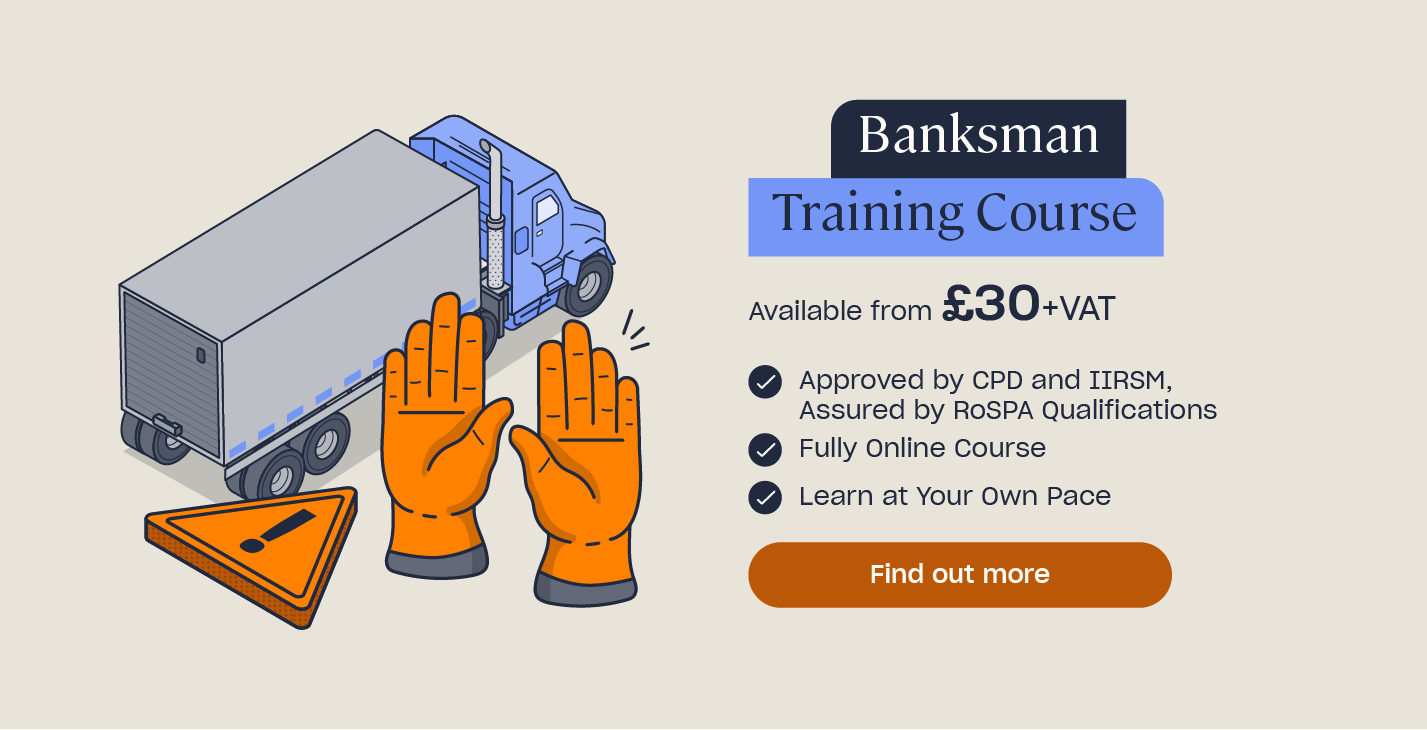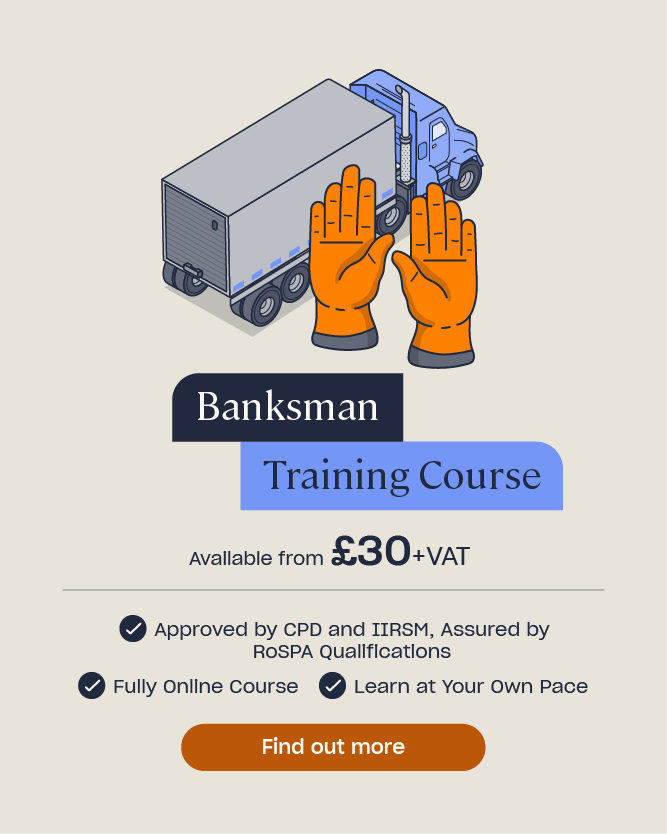Banksman Signals: Free Poster
A banksman, also commonly referred to as a traffic marshal, is used in a variety of industries to direct the operations and manoeuvres of vehicles and mobile plant, where the risks from those operations cannot be adequately controlled by other measures. Controlling the risks is crucial as they can otherwise result in major injuries and even fatalities, and unfortunately many incidents involving work vehicles are reported every year. According to the Health and Safety Executive, there are over 5,000 accidents annually involving workplace transport.
Using a properly trained and competent banksman can be one of the control measures for minimising these risks. In order to be competent to carry out their role, banksmen or traffic marshals will need to receive practical training specific to their work activities and work environment. Part of this training will likely involve learning the signalling system that should be used to guide drivers and operators, which is a key part of their role.
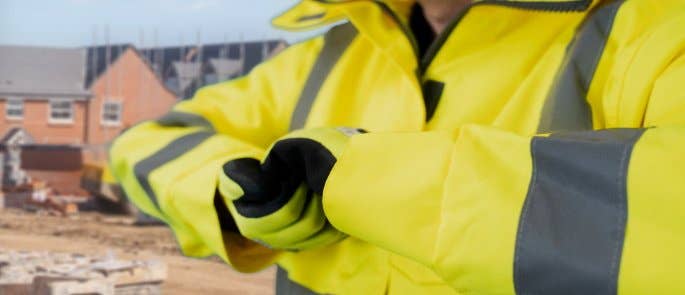
In this article, we will look at the hand signals commonly used by banksmen and provide you with a downloadable poster of the hand signals to take away.
What are Banksman Signals?
Banksmen usually use hand signals to communicate with drivers or operators when directing operations or manoeuvres. The commonly used hand signals are set out in the Health and Safety (Safety Signs and Signals) Regulations 1996 (the ‘Signs and Signals Regulations’).
Although these are the commonly used hand signals across Europe, any signals may be used, as long as they are agreed between the banksman and driver/operator before operations commence. This is why practical training that is specific to the work activities and work environment is so important.
There are 12 signals set out in the Signs and Signals Regulations. Three of these signals are specifically for lifting operations, and so would only be used by slinger-signallers. These signals are beyond the scope of this article.
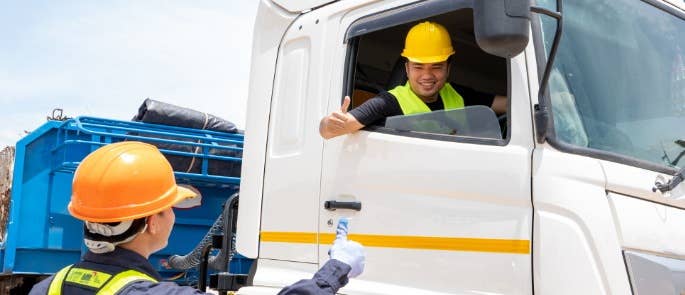
The nine signals commonly used by banksmen/traffic marshals (and set out in the attached poster at the end of the article) are:
Start
The start signal is used to indicate to the driver or operator that they can begin moving the vehicle.
This signal involves extending both arms fully outwards, so they are roughly at a 90-degree angle from the torso.

Move forwards
The move forwards signal is used to tell the driver or operator that they can start moving the vehicle forwards.
This signal is also sometimes referred to as ‘move towards the banksman’, which is useful for clarity if the vehicle or mobile plant is reversing and the banksman is directing from a safe area behind it.
It involves the banksman moving both arms up and down towards their chest, with their palms facing upwards towards their face.

Move backwards
The move backwards signal is the opposite of the move forwards one. It is used to tell the driver or operator that they can start moving the vehicle backwards.
This signal is also sometimes referred to as ‘move away from the banksman’, which is useful for clarity if the banksman is directing from a safe area behind the vehicle or mobile plant.
It involves the banksman moving both arms up and down towards their chest, but opposite to the move forwards signal the palms should be facing out and down.

Move to the bankman’s right
This signal is used to notify the driver or operator that they should move the vehicle to the banksman’s right.
It involves the banksman extending their right arm fully outwards, roughly at a 90-degree angle from their torso, with their fingers extended and palm facing downwards towards the floor.

Move to the banksman’s left
This signal is used to notify the driver or operator that they should move the vehicle to the banksman’s left.
It involves the banksman extending their left arm fully outwards, roughly at a 90-degree angle from their torso, with their fingers extended and palm facing downwards towards the floor.

Horizontal distance
The horizontal distance signal is used to help the driver or operator know what distance they should move.
It involves the banksman indicating a distance with their palms facing each other, and moving the palms away or towards each other to indicate increasing or decreasing distance.

Danger
The danger signal is used when a safety risk has arisen during the manoeuvre and so the driver or operator needs to perform an emergency stop.
It involves the banksman raising both their arms upwards above their heads, with palms facing outwards. The arms should be slightly bent at the elbow (not fully extended in a V shape).

Stop
The stop signal is used to indicate to the driver or operator that they should stop the vehicle. Unlike the danger signal, this doesn’t require the driver to do an emergency stop, but rather they can come to a natural stop.
The signal involves the banksman raising their right hand upwards above their head, elbow slightly bent so the arm is not fully straight, with their palm facing outwards.

End
The end signal is used to tell the driver or operator that they can stop the vehicle and end the manoeuvre.
It involves the banksman cupping their hands together in front of their chest.

Verbal signals are occasionally used by banksmen. However, these are less common than hand signals. They are sometimes used when directing manoeuvres for particularly large vehicles or mobile plant, where it is not possible for the banksman to stand in a position of safety when directing the vehicle using hand signals. Two-way, hands-free radios are often used for these verbal signals.
Key points to remember when using either hand or verbal signals are:
- A clear system of signalling should be used.
- Signals should be agreed in advance between the banksman and driver/operator.
- The banksman should be visible to the driver/operator at all times.
- The driver/operator should know to stop operations immediately if they can no longer see the banksman.
- The banksman should never stand in the vehicles hazard’s areas (i.e. where there is restricted or vision for the driver or operator).
Why are Banksman Signals Important?
A banksman or traffic marshal is used to direct vehicle or mobile plant operations when other control measures are not sufficient to reduce the risks from the operations. It is therefore vital that the signals they use to communicate with the drivers or operators are clear, and that everyone is familiar with the signals that are being used.
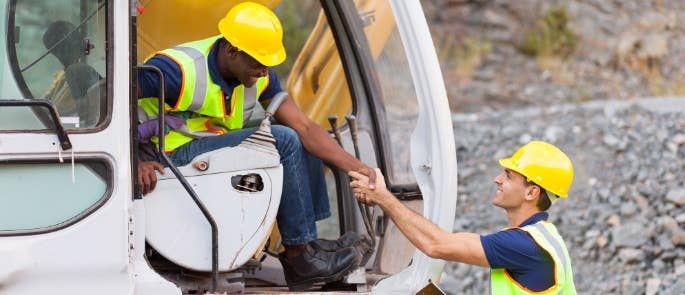
For example, on a construction site, a banksman might be used to direct the operations of an excavator, ensuring that the area is free from pedestrians and that the operator is able to safety carry out manoeuvres.
There are a significant number of vehicle related accidents every year in workplaces. Ensuring control measures (potentially including the use of banksmen) are in place can help to minimise those risks. Good communication is an essential part of those controls.
Want to Learn More?
Our Banksman Training is an awareness level course that helps learners understand how to fulfil their role of supporting safe vehicle and mobile plant operations.
As well as being familiar with the signals used to direct vehicle and mobile plant operations, banksmen must give clear instructions to any pedestrians in the area and any other workers in the vicinity of the operations.
For more information on the importance of good communication in construction, see our article What is Effective Communication in Construction?
Free Banksman Signals Poster
This poster includes the hand signals set out in the Signs and Signals Regulations. They are the most commonly used signals across Europe. However, as discussed earlier, any signals may be used, as long as everyone involved is aware of the signals and they are agreed in advance.
In workplaces where these commonly used signals are used by banksman, this poster can be displayed to act as a reminder of the signals. Practical training should also be provided on the use of the signals to ensure that everyone is aware of how the signals are used in practise and what they mean.
What to Read Next:
- What is a Banksman? Duties and Responsibilities
- What is Effective Communication in Construction?
- Toolbox Talks in Construction: Guidance on Meeting Topics and Resources
- Banksman Training Course


